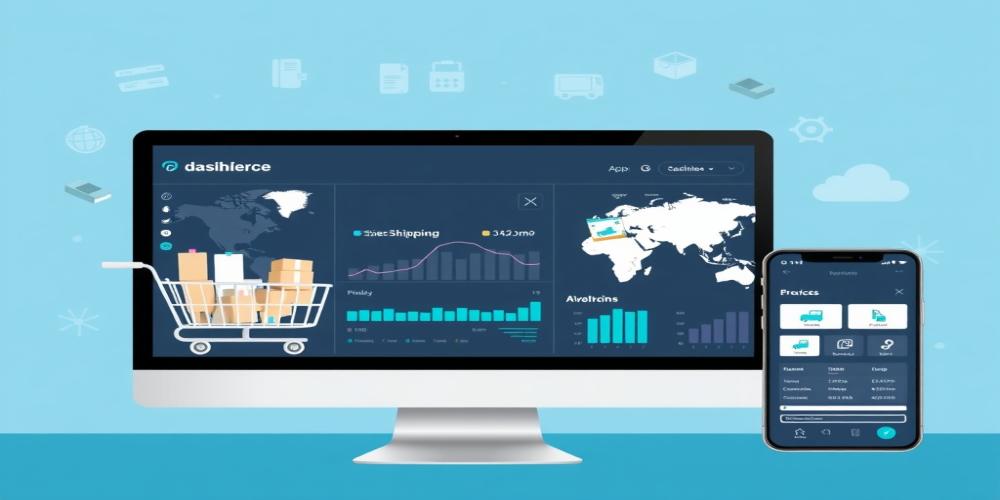E-commerce & Dropshipping: The Ultimate Guide to Building a Profitable Online Business
Introduction to E-commerce and Dropshipping
The digital revolution has transformed the way we shop, leading to an exponential growth in e-commerce. Among the various business models within this digital marketplace, dropshipping has emerged as a particularly attractive option for aspiring entrepreneurs. This comprehensive guide will explore the fundamentals of e-commerce and dropshipping, helping you understand how to build and grow a profitable online business.
What is Dropshipping?
Dropshipping is a retail fulfillment method where a store doesn't keep the products it sells in stock. Instead, when a store sells a product, it purchases the item from a third party—usually a wholesaler or manufacturer—who then ships the product directly to the customer. As a result, the seller never sees or handles the product.
Benefits of Dropshipping
Low Startup Costs
One of the most significant advantages of dropshipping is the minimal financial risk. Traditional retail requires substantial capital for inventory, while dropshipping eliminates this expense. You only purchase a product when you've already made the sale and have been paid by the customer.
Wide Selection of Products
Since you don't need to pre-purchase inventory, you can offer a wide variety of products to your customers. This flexibility allows you to test and discover which products perform best without financial risk.
Location Independence
As long as you have an internet connection, you can run your dropshipping business from anywhere in the world. This freedom to operate from anywhere makes dropshipping an attractive option for digital nomads and those seeking a flexible lifestyle.
Challenges of Dropshipping
Thin Profit Margins
Because of the competition and the wholesale prices you pay to your supplier, profit margins can be thin. Careful pricing strategy and efficient operations are essential to remain profitable.
Inventory Management
While you don't handle the products, you're still responsible for inventory management. If a supplier runs out of stock, you could end up with backorders and unhappy customers.
Shipping Complexities
With multiple suppliers, shipping times and costs can vary significantly. This inconsistency can complicate your shipping policies and create challenges in meeting customer expectations.
How to Start a Dropshipping Business
Step 1: Research and Validate Your Niche
The foundation of a successful dropshipping business is a well-researched niche. Look for products with high demand but low competition. Use tools like Google Trends, social media platforms, and competitor analysis to identify profitable opportunities.
Step 2: Find Reliable Suppliers
Your suppliers are crucial to your business's success. Look for partners who offer competitive pricing, reliable shipping, and quality products. Popular platforms for finding suppliers include AliExpress, SaleHoo, and Worldwide Brands.
Step 3: Build Your Online Store
Choose an e-commerce platform that suits your needs. Shopify is a popular choice for dropshipping due to its user-friendly interface and extensive app ecosystem. Your store should have a professional design, clear product descriptions, and a seamless checkout process.
Step 4: Implement Marketing Strategies
Driving traffic to your store is essential for making sales. Utilize a mix of digital marketing channels including social media marketing, search engine optimization (SEO), content marketing, and paid advertising.
Choosing Profitable Products
Consider Seasonality and Trends
Some products perform better during specific seasons or align with current trends. While these can offer short-term opportunities, building a sustainable business often requires products with year-round demand.
Analyze Product Reviews
Review customer feedback on potential products to identify common complaints. Products with consistently positive reviews and few complaints are generally safer bets.
Evaluate Shipping Times
Long shipping times can lead to customer dissatisfaction. Whenever possible, choose suppliers who offer faster shipping options, even if they come at a slightly higher cost.
Customer Service Excellence
In dropshipping, excellent customer service is non-negotiable. Since you don't control the fulfillment process, clear communication is essential. Set realistic expectations about shipping times and be transparent about potential delays. Implement a responsive customer service system to address inquiries and resolve issues promptly.
Scaling Your Dropshipping Business
Diversify Your Product Range
As your business grows, expand your product offerings to increase average order value and attract different customer segments.
Build Your Brand
Transition from selling generic products to building a recognizable brand. Create custom packaging, develop a unique brand voice, and cultivate a community around your brand.
Explore New Markets
Once you've established your presence in one market, consider expanding to new geographic regions or demographic segments.
Future Trends in E-commerce and Dropshipping
AI and Personalization
Artificial intelligence is transforming e-commerce by enabling personalized shopping experiences and optimizing inventory management.
Social Commerce
Platforms like Instagram and TikTok are evolving into shopping destinations, allowing consumers to purchase products directly through social media.
Sustainability and Ethical Sourcing
As consumers become more environmentally conscious, dropshippers who prioritize sustainable practices and ethical sourcing will have a competitive advantage.
Conclusion
Dropshipping represents an accessible entry point into the world of e-commerce, offering entrepreneurs the opportunity to build a business with minimal upfront investment. While challenges exist, those who approach dropshipping with careful planning, attention to detail, and a commitment to customer satisfaction can build profitable and sustainable online businesses.
Success in dropshipping requires continuous learning and adaptation. Stay informed about industry trends, monitor your competitors, and always prioritize the customer experience. With persistence and strategic execution, your dropshipping business can thrive in the competitive e-commerce landscape.










